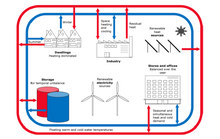
Cold district heating is a technical variant of a district heating network that operates at low transmission temperatures well below those of conventional district heating systems and can provide both space heating and cooling. Transmission temperatures in the range of approx. 10 to 25 °C are common, allowing different consumers to heat and cool simultaneously and independently of each other. Hot water is produced and the building heated by water heat pumps, which obtain their thermal energy from the heating network, while cooling can be provided either directly via the cold heat network or, if necessary, indirectly via chillers. Cold local heating is sometimes also referred to as an anergy network. The collective term for such systems in scientific terminology is 5th generation district heating and cooling. Due to the possibility of being operated entirely by renewable energies and at the same time contributing to balancing the fluctuating production of wind turbines and photovoltaic systems, cold local heating networks are considered a promising option for a sustainable, potentially greenhouse gas and emission-free heat supply.